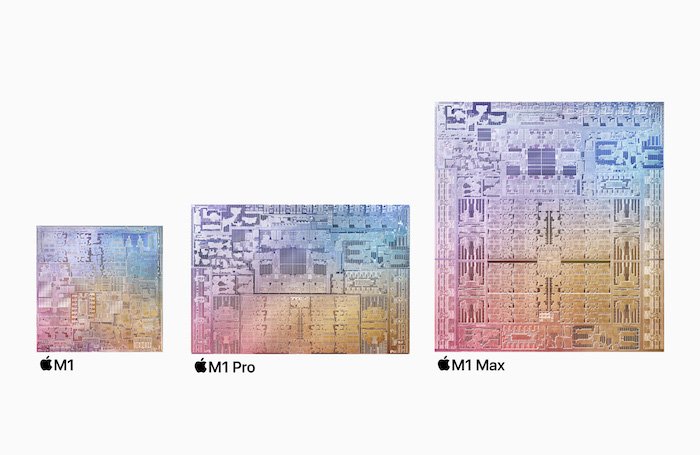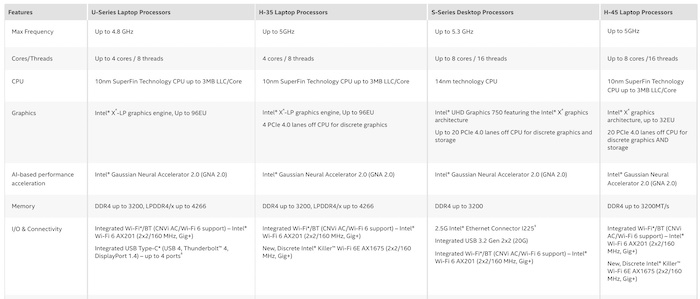On Monday, Apple unveiled the next generation of its system-on-chip (SoC) platform for the Apple MacBook Pro. The SoC is available in two configurations, the M1 Pro and M1 Max.
Similar to what the A15 release last month did to the A14, this new generation of hardware appears to completely dwarf the capabilities of last years’ M1 SoC for Mac.
Overall, the new SoCs feature 10-cores with up to a 32-core GPU and up to 64-GB of unified memory. The M1 Max, which maxes out all these specifications, is the largest chip Apple has ever built.

Three SoCs, two generations, all 5-nm node size. Image used courtesy of Apple
Today, this article will examine the generational advancements in the Apple silicon, compare the differences between the M1 Pro and M1 Max, and then overview the newest Intel Core 11th-generation processors introduced at CES 2021 in an attempt to glean some performance comparisons.
Apple Builds on Past Design Successes
A quick look at the silicon of the M1 Pro and M1 Max quickly tells designers that Apple has traded die size for improved performance. Despite the technically imprecise term of “relative performance,” Apple’s marketing team shows just how competitive the market is.

Leaping over the competition in performance per watt with M1 Pro / M1 Max. Image used courtesy of Apple
While last years' M1 boasts superior performance vs power against competitors' 8-core chips, it pales when evaluated against performance as a solo metric. The competition for technical excellence never ends, and this is where the M1 Pro and M1 Max take the lead this year.
As always, Apple limits one's ability to break down detailed M1 Pro/Max specifications, but it does offer select specifications to compare to last year's M1.
M1 Pro compared to M1:
- 10 core vs 8 core - 8 (+4) performance, 2 (-2) high efficiency
- 33.7 billion transistors on-board (110.63% increase), providing 1.7x increased performance against competitors at the same power level
- Up to 32 GB of unified memory with 200 GB/s bandwidth
- Up to 16-core GPU (+8 over M1) offering 2x faster-integrated graphics
M1 Max compared to M1:
- Identical core architecture to the M1 Pro
- 57 billion transistors on-board (256.25% increase) over the M1
- Up to 64 GB of unified memory with 400 GB/s bandwidth (6x the M1)
- 32-core GPU (+24 over M1) offering 4x faster-integrated graphics
The M1 Max is said to have performance comparable to the industry's leading high-end GPUs in PC laptops but uses 100 W less power.

The M1 Max claims to compete for best-in-class GPU performance, with superior performance per watt. Image used courtesy of Apple
Although the exact architecture isn't revealed, it is interesting to note that these SoCs offer the same 16-core neural engine count as the A15. This neural engine claims to be 2x faster than the M1, which could indicate that Apple is taking advantage of IP re-use in the rapid development of its silicon.
Do Intel’s 11th-Gen Core Processors Compete with SoC Design?
Due to the differences in architecture between a processor and a complete system-on-chip design, it is difficult to compare "Apples to Apples" (pun intended).
However, all things being equal, a discerning designer would be interested in reviewing power usage, process node size, and core count.
The 11th-generation Intel Core U-series is said to use 25 watts. Meanwhile, the H-series uses 35 watts. Both processors possess up to 4-cores, running upwards of 5 GHz, built using 10 nm SuperFin Technology, and feature integrated graphics capabilities.

Key specifications for the U/H-series Intel 11th-gen Core laptop processors. Image (modified) used courtesy of Intel
Beyond these basic specs, designers will need to wait until benchmark enthusiasts have an opportunity to get more concrete data from running real MacBook Pro versus PC Laptop setups to determine who is the champion in 2021.
Final Thoughts
Experience generally lends itself to improved performance. Apple, now entering its 2nd year of in-house SoC development, demonstrates this hypothesis with the M1 Pro and M1 Max release.
SoC design has gone mainstream as a solution for advanced processing capabilities with unparalleled performance per watt. The question left to ask today is whether or not Intel (or maybe AMD) will move deeper, and with speed, into the SoC design space in the near future.
